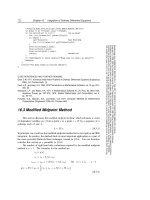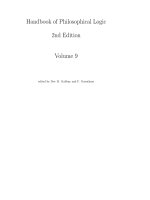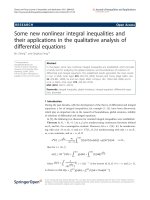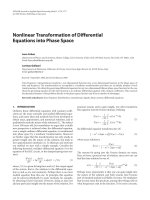Chipot m (ed ) handbook of differential equations vol 4
Bạn đang xem bản rút gọn của tài liệu. Xem và tải ngay bản đầy đủ của tài liệu tại đây (3.15 MB, 627 trang )
H ANDBOOK
OF D IFFERENTIAL E QUATIONS
S TATIONARY PARTIAL
D IFFERENTIAL E QUATIONS
VOLUME IV
This page intentionally left blank
H ANDBOOK
OF D IFFERENTIAL E QUATIONS
S TATIONARY PARTIAL
D IFFERENTIAL E QUATIONS
Volume IV
Edited by
M. CHIPOT
Institute of Mathematics, University of Zürich, Zürich, Switzerland
Amsterdam • Boston • Heidelberg • London • New York • Oxford
Paris • San Diego • San Francisco • Singapore • Sydney • Tokyo
North-Holland is an imprint of Elsevier
Radarweg 29, PO Box 211, 1000 AE Amsterdam, The Netherlands
The Boulevard, Langford Lane, Kidlington, Oxford OX5 1GB, UK
First edition 2007
Copyright © 2007 Elsevier B.V. All rights reserved
No part of this publication may be reproduced, stored in a retrieval system or transmitted in any form or
by any means electronic, mechanical, photocopying, recording or otherwise without the prior written
permission of the publisher
Permissions may be sought directly from Elsevier’s Science & Technology Rights Department in Oxford, UK: phone (+44) (0) 1865 843830; fax (+44) (0)1865 853333; email:
Alternatively you can submit your request online by visiting the Elsevier web site at />locate/permissions, and selecting Obtaining permission to use Elsevier material
Notice
No responsibility is assumed by the publisher for any injury and/or damage to persons or property as
a matter of products liability, negligence or otherwise, or from any use or operation of any methods,
products, instructions or ideas contained in the material herein. Because of rapid advances in the medical sciences, in particular, independent verification of diagnoses and drug dosages should be made
Library of Congress Cataloging-in-Publication Data
A catalog record for this book is available from the Library of Congress
British Library Cataloguing-in-Publication Data
A catalogue record for this book is available from the British Library
ISBN-13: 978-0-444-53036-3
Set ISBN: 0 444 51743-x
For information on all North-Holland publications
visit our web site at books.elsevier.com
Printed and bound in The Netherlands
07 08 09 10 11 10 9 8 7 6 5 4 3 2 1
Preface
This handbook is the volume IV in a series devoted to stationary partial differential equations. As the preceding volumes, it is a collection of self contained, state-of-the-art surveys
written by well-known experts in the field.
The topics covered by this volume include rearrangements techniques and applications, Liouville-type theorems, similarity solutions of degenerate boundary layer equations,
monotonicity and compactness methods for nonlinear variational inequalities, stationary
Navier–Stokes flow in two dimensional channels, the investigation of singular phenomena in nonlinear elliptic problems. It includes also a very complete study of the maximum
principles for elliptic partial differential equations. I hope that these surveys will be useful for both beginners and experts and help to the diffusion of these recent deep results in
mathematical science.
I would like to thank all the contributors for their elegant articles. I also thank Arjen
Sevenster and Andy Deelen at Elsevier for the excellent editing work of this volume.
M. Chipot
v
This page intentionally left blank
List of Contributors
Brock, F., Departamento de Matemáticas, Universidad de Chile, Casilla 653, Chile (Ch. 1)
Farina, A., LAMFA, CNRS UMR 6140, Université de Picardie Jules Verne, Faculté de
Mathématiques et d’Informatique, 33, rue Saint-Leu, 80039 Amiens, France (Ch. 2)
Guedda, M., LAMFA, CNRS UMR 6140, Université de Picardie Jules Verne, Faculté de
Mathématiques et d’Informatique, 33, rue Saint-Leu 80039 Amiens, France (Ch. 3)
Kenmochi, N., Department of Mathematics, Chiba University, L-33 Yayoi-cho, InageKu 263, Chiba, 263-8222 Japan (Ch. 4)
Morimoto, H., Department of Mathematics, Meiji University, 1-1-1 Higashi-mita, Tanakaku, Kanagawa, Kawasaki, 214 8571, Japan (Ch. 5)
Pucci, P., Dipartimento di Matematica e Informatica, Università degli Studi di Perugia,
Via Vanvitelli 1, Perugia, Italy (Ch. 6)
R˘adulescu, V.D., Department of Mathematics, University of Craiova, 200585 Craiova, Romania and Institute of Mathematics of the Romanian Academy, P.O. Box 1-764, 014700
Bucharest, Romania (Ch. 7)
Serrin, J., Department of Mathematics, University of Minnesota, Minneapolis, MN, USA
(Ch. 6)
vii
This page intentionally left blank
Contents
Preface
List of Contributors
Contents of Volume I
Contents of Volume II
Contents of Volume III
v
vii
xi
xiii
xv
1. Rearrangements and Applications to Symmetry Problems in PDE
F. Brock
2. Liouville-Type Theorems for Elliptic Problems
A. Farina
3. Similarity and Pseudosimilarity Solutions of Degenerate Boundary Layer Equations
M. Guedda
4. Monotonicity and Compactness Methods for Nonlinear Variational Inequalities
N. Kenmochi
5. Stationary Navier–Stokes Flow in 2-D Channels Involving the General Outflow
Condition
H. Morimoto
6. Maximum Principles for Elliptic Partial Differential Equations
P. Pucci and J. Serrin
7. Singular Phenomena in Nonlinear Elliptic Problems: From Blow-Up Boundary
Solutions to Equations with Singular Nonlinearities
V.D. R˘adulescu
1
61
117
203
299
355
485
Author Index
595
Subject Index
603
ix
This page intentionally left blank
Contents of Volume I
Preface
List of Contributors
v
vii
1. Solutions of Quasilinear Second-Order Elliptic Boundary Value Problems via
Degree Theory
C. Bandle and W. Reichel
2. Stationary Navier–Stokes Problem in a Two-Dimensional Exterior Domain
G.P. Galdi
3. Qualitative Properties of Solutions to Elliptic Problems
W.-M. Ni
4. On Some Basic Aspects of the Relationship between the Calculus of Variations
and Differential Equations
P. Pedregal
5. On a Class of Singular Perturbation Problems
I. Shafrir
6. Nonlinear Spectral Problems for Degenerate Elliptic Operators
P. Takáˇc
7. Analytical Aspects of Liouville-Type Equations with Singular Sources
G. Tarantello
8. Elliptic Equations Involving Measures
L. Véron
1
71
157
235
297
385
491
593
Author Index
713
Subject Index
721
xi
This page intentionally left blank
Contents of Volume II
Preface
List of Contributors
Contents of Volume I
v
vii
xi
1. The Dirichlet Problem for Superlinear Elliptic Equations
T. Bartsch, Z.-Q. Wang and M. Willem
2. Nonconvex Problems of the Calculus of Variations and Differential Inclusions
B. Dacorogna
3. Bifurcation and Related Topics in Elliptic Problems
Y. Du
4. Metasolutions: Malthus versus Verhulst in Population Dynamics. A Dream
of Volterra
J. López-Gómez
5. Elliptic Problems with Nonlinear Boundary Conditions and the Sobolev
Trace Theorem
J.D. Rossi
6. Schrödinger Operators with Singular Potentials
G. Rozenblum and M. Melgaard
7. Multiplicity Techniques for Problems without Compactness
S. Solimini
1
57
127
211
311
407
519
Author Index
601
Subject Index
609
xiii
This page intentionally left blank
Contents of Volume III
Preface
List of Contributors
Contents of Volume I
Contents of Volume II
v
vii
xi
xiii
1. Elliptic Equations with Anisotropic Nonlinearity and Nonstandard Growth
Conditions
S. Antontsev and S. Shmarev
2. A Handbook of Γ -Convergence
A. Braides
3. Bubbling in Nonlinear Elliptic Problems Near Criticality
M. del Pino and M. Musso
4. Singular Elliptic and Parabolic Equations
J. Hernández and F.J. Mancebo
5. Schauder-Type Estimates and Applications
S. Kichenassamy
6. The Dam Problem
A. Lyaghfouri
7. Nonlinear Eigenvalue Problems for Higher-Order Model Equations
L.A. Peletier
1
101
215
317
401
465
553
Author Index
605
Subject Index
613
xv
This page intentionally left blank
CHAPTER 1
Rearrangements and Applications to Symmetry
Problems in PDE
F. Brock
Departamento de Matemáticas, Universidad de Chile, Casilla 653, Chile
E-mail:
In honor of the 65th birthday of Albert Baernstein II
Contents
1. Introduction . . . . . . . . . . .
2. Basic definitions . . . . . . . .
3. Rearrangements . . . . . . . . .
3.1. General properties . . . . .
3.2. Two-point rearrangement .
3.3. Symmetrizations . . . . . .
4. Inequalities for symmetrizations
5. Symmetry results . . . . . . . .
5.1. Uniformly elliptic case . .
5.2. Degenerate elliptic case . .
6. Other symmetry results . . . . .
List of notations . . . . . . . . . .
Acknowledgement . . . . . . . . .
References . . . . . . . . . . . . .
.
.
.
.
.
.
.
.
.
.
.
.
.
.
.
.
.
.
.
.
.
.
.
.
.
.
.
.
.
.
.
.
.
.
.
.
.
.
.
.
.
.
.
.
.
.
.
.
.
.
.
.
.
.
.
.
.
.
.
.
.
.
.
.
.
.
.
.
.
.
.
.
.
.
.
.
.
.
.
.
.
.
.
.
.
.
.
.
.
.
.
.
.
.
.
.
.
.
.
.
.
.
.
.
.
.
.
.
.
.
.
.
.
.
.
.
.
.
.
.
.
.
.
.
.
.
.
.
.
.
.
.
.
.
.
.
.
.
.
.
.
.
.
.
.
.
.
.
.
.
.
.
.
.
.
.
.
.
.
.
.
.
.
.
.
.
.
.
.
.
.
.
.
.
.
.
.
.
.
.
.
.
.
.
.
.
.
.
.
.
.
.
.
.
.
.
.
.
.
.
.
.
.
.
.
.
.
.
.
.
.
.
.
.
.
.
.
.
.
.
.
.
.
.
.
.
.
.
.
.
.
.
.
.
.
.
.
.
.
.
.
.
.
.
.
.
.
.
.
.
.
.
.
.
.
.
.
.
.
.
.
.
.
.
.
.
.
.
.
.
.
.
.
.
.
.
.
.
.
.
.
.
.
.
.
.
.
.
.
.
.
.
.
.
.
.
.
.
.
.
.
.
.
.
.
.
.
.
.
.
.
.
.
.
.
.
.
.
.
.
.
.
.
.
.
.
.
.
.
.
.
.
.
.
.
.
.
.
.
.
.
.
.
.
.
.
.
.
.
.
.
.
.
.
.
.
.
.
.
.
.
.
.
.
.
.
.
.
.
.
.
.
.
.
.
.
.
.
.
.
.
.
.
.
.
.
.
.
.
.
.
.
.
.
.
.
.
.
.
.
.
.
.
.
.
.
.
.
.
.
.
.
.
.
.
.
.
.
.
.
.
.
.
.
.
.
.
.
.
.
.
.
.
.
.
.
.
.
.
.
.
.
.
.
.
.
.
.
.
.
.
.
.
.
.
.
.
.
.
.
.
.
.
.
.
.
.
.
.
.
.
.
.
.
.
.
.
.
.
.
.
.
.
.
.
.
.
.
.
.
.
.
.
.
.
.
.
.
.
.
.
.
.
.
.
.
.
.
.
.
.
.
.
.
.
.
.
.
.
.
.
.
.
.
.
.
.
.
.
.
.
.
.
.
.
.
.
.
.
.
.
.
.
.
.
.
.
.
.
.
.
.
.
.
.
.
.
.
.
.
Abstract
This survey is meant as a general introduction to the theory of rearrangements on RN .
We give proofs of all the basic integral inequalities for symmetrization, and a number of applications to symmetry problems in PDE. A particular rôle plays the method of two-point
rearrangement.
HANDBOOK OF DIFFERENTIAL EQUATIONS
Stationary Partial Differential Equations, volume 4
Edited by M. Chipot
© 2007 Elsevier B.V. All rights reserved
1
3
6
6
7
15
19
24
37
37
42
51
54
55
55
This page intentionally left blank
Rearrangements and applications to symmetry problems in PDE
3
1. Introduction
Consider a variational problem of the following form
(P)
J (v) ≡
Ω
1
|∇v|p − F (x, v) dx −→ Stat.!,
p
v ∈ K,
(1.1)
1,p
where K is a closed subset of W0 (Ω), p 1, and Ω is a domain in RN . The nonnegative
minimizers of problems like (P) describe stable – so-called ground – states of equilibria,
as they appear in plasma physics, heat conduction and chemical reactors (see [55,63,88,89,
78,107], and the references cited therein). We ask for symmetries of the solutions of (P), if
F and Ω have certain “symmetries”. A well-known result is the following.
Let v denote the Schwarz symmetrization of v (for a definition see Section 3.3). Assume that Ω = RN , or Ω = BR (R > 0), F = F (v) and F is continuous, and K contains
only nonnegative functions and has the property that, if v ∈ K, then also v ∈ K. Then
J (v )
(1.2)
J (v).
If, in addition, problem (P) has a unique global minimizer u, then we obtain from (1.2)
that u = u . (Note that this means that u is radially symmetric and radially nonincreasing,
i.e.
u = u |x| and u is nonincreasing in r (r = |x|).)
However, if the global minimizer is not unique, then the question arises whether there still
holds equality in (1.2) if v = v . Unfortunately, this cannot be excluded in general, as the
following simple example shows (see [38]).
E XAMPLE 1.1. Let F ≡ 0. Then there are nonnegative smooth functions v with compact support which are not radially symmetric and satisfy J (v) = J (v ). Their superlevel
sets {v > c}, c > 0, are nested balls which, however, might be nonconcentric, and the set
{∇v = 0} has nonempty interior, that is the graph of v has “plateaus”.
Physically relevant are not only the global minima but also the local minima and critical
points of (P). To show symmetry properties of these functions, the above argument fails,
because in general the Schwarz symmetrization v is not close to v. Even though one
expects symmetric solutions in many cases, there are again exceptions. Here is another
typical example.
E XAMPLE 1.2 (Semilinear problem for the p-Laplacian). Let B be a ball in RN with
2
center 0, f ∈ C(R+
0 ), p > 1, and let u ∈ C (B) satisfy
−
p u ≡ −∇
|∇u|p−2 ∇u = f (u),
u = 0 on ∂B.
u > 0 in B,
(1.3)
4
F. Brock
Note that the associated variational problem is
B
1
|∇v|p − F (u) dx −→ Stat.!,
p
1,p
v ∈ W0 (B),
(1.4)
where
v
F (v) :=
f (z) dz.
0
If p = 2 and f is smooth then it is well known (see [64]) that
u=u
and
∂u
< 0 in B \ {0} r = |x| .
∂r
(1.5)
However, if p > 2 or if f is not smooth, then the conclusion (1.5) holds only under some
additional assumptions. Below we give a short (but not complete) list of sufficient criteria
for (1.5).
(i) p = 2 and f = f1 + f2 , where f1 is smooth and f2 is increasing, [64];
(ii) p = N and f (v) > 0 for v > 0, [75] (see also [87] for the case p = N = 2);
(iii) f ∈ C 1 (R+
0 ) and ∇u vanishes only at 0, [17];
(iv) f ∈ C 1 (R+
2, [50] and [103].
0 ) and 1 < p
The proofs for (i), (iii) and (iv) use the so-called Moving Plane Method (MPM) which
turned out to be a very powerful technique in proving symmetry results for positive solutions of elliptic and parabolic problems in symmetric domains during the last two decades.
Important references for uniformly elliptic equations are [102,64,65,24–26,82,83,80,81],
and [42]. There have also been obtained symmetry results for some degenerate elliptic
equations including in particular the case of the p-Laplacian operator for p ∈ (1, 2) during
the last 5 years, see [49–51,67,52,53,103], and [54].
The (MPM) exploits comparison principles for elliptic equations while using the invariance of the equation with respect to reflections. We emphasize that the nonnegativity
assumption on the solution is needed to make the method work. Furthermore, if the differential operator of the problem degenerates and/or the nonlinearity f in (1.3) is not smooth,
then the (MPM) is often applicable only under additional assumptions on the solution. This
concerns, for instance, the p-Laplacian operator for p > 2 (compare the cases (iii) and (iv)
above).
Notice that the result (ii) was proved by combining an isoperimetric inequality and a
Pohozaev-type identity. However this method is not applicable if p = N .
One can construct radially symmetric solutions of (1.3) for which the second condition
in (1.5) fails if either p > 2 and f is smooth, or if p ∈ (1, 2] and f is Hölder continuous
(see [67]). Moreover, if p = 2 and f is only continuous and changes sign, then we cannot
hope that the solution of (1.3) is radially symmetric. Below we give examples of solutions
in the case p 2 which have a plateau and two radially symmetric “shifted bumps” on it
(see [33]). Note that similar examples can also be found in the recent paper [103].
Rearrangements and applications to symmetry problems in PDE
Let p
5
2, s > 2,
w(x) =
(1 − |x|2 )s
0
v(x) =
1
1 − ((|x|2 − 25)/11)s
if |x| 1,
if |x| > 1,
We choose x 1 , x 2 ∈ B4 with |x 1 − x 2 |
and
if |x| < 5,
if 5 |x| 6.
2 and set
u(x) := v(x) + w x − x 1 + w x − x 2 ,
x ∈ B6 .
The graph of u is built up by three radially symmetric “mountains”, one of them having a
“plateau” at height 1 while the other two are congruent to each other with their “feet” lying
on the plateau. After a short computation we see that u is a solution of (1.4) with B = B6
and
⎧
(2s/11)p−1 (25 + 11(1 − u)1/s )(p/2)−1 (1 − u)p−(p/s)−1
⎪
⎪
⎪
⎪
⎪
× {(50/11)(p − 1)(s − 1) + (2ps − 2s − p + n)(1 − u)1/s }
⎪
⎪
⎪
⎨
if 0 u 1,
f (u) :=
p−1
⎪
(2s)
(1 − (u − 1)1/s )(p/2)−1 (u − 1)p−(p/s)−1
⎪
⎪
⎪
⎪
⎪ × {−2(s − 1)(p − 1) + (2ps − 2s − p + n)(u − 1)1/s }
⎪
⎪
⎩
if 1 u 2.
If p = 2 and s > 2 then we have f ∈ C ∞ ([0, 2] \ {1}) ∩ C 1−(2/s) ([0, 2]). The difference
quotient of f is not bounded below near u = 1, i.e. f ∈
/ C 1 ([0, 2]). In contrast, if p > 2
1
and s > p/(p − 2), then we have f ∈ C ([0, 2]).
On the other hand, the functions in the above examples are distinguished by some “local”
symmetry which can be described as follows:
(LS) Every connected component of {x ∈ B: u(x) > 0, ∇u = 0} is an annulus A of the
form BR2 (z) \ BR1 (z) (R2 > R1 0, z ∈ B), u is radially symmetric in A, that is
u(x) = v(|x − z|) and ∂v/∂r < 0 for R2 > r > R1 .
Our aim is to obtain those weak – and also other – symmetries for stationary solutions
of problems like (P), using rearrangement arguments. Our approach is closely related to
the corresponding variational problems of the differential equations. But in contrast to the
(MPM), we can deal with a large class of degenerate operators, and also with nonsmooth
nonlinearities in the equations. Furthermore, we may sometimes drop the nonnegativity
assumption provided that the solution is a minimizer of the corresponding variational problem.
We would like to refer the interested reader to the nice survey of H. Brezis [29], where
a lot of challenging open symmetry problems in PDE can be found.
We now outline the content of our work. In Section 3.1 we investigate a general class
of rearrangements on RN . There is no doubt that slight modifications of these results hold
as well in other situations. In Section 3.2 we study the two-point rearrangement. This very
6
F. Brock
simple type of rearrangement will then be helpful in Sections 3.3 and 4 to show many
properties of the Schwarz, Steiner and cap symmetrizations, including all the basic inequalities that compare an integral of some given functions with the same integral of their
symmetrizations. In Section 5 we obtain symmetry properties for minimizers of elliptic
variational problems, where we combine the two-point rearrangement with two important
tools in PDE: the Principle of Unique continuation (Section 5.1) and the Strong Maximum
Principle (Section 5.2). These results are contained in two recent articles of the author,
[35,36]). Finally we briefly report on other symmetry results in Section 6, in particular
those which have been obtained using the method of continuous Steiner symmetrization
(see [30,32,33].
2. Basic definitions
We will assume N ∈ N, N 2 throughout our work. We write x = (x1 , . . . , xN ) =
√(x1 , x ),
y = (y1 , . . . , yN ) = (y1 , y ), . . . , for points in RN , and x · y = N
x
y
,
|x|
=
x · x for
i=1 i i
the Euclidean scalar product and norm, respectively.
Let Lk denote k-dimensional Lebesgue measure, 1 k N . and let M denote the set
of all L-measurable – measurable in short – sets of RN . By · p,M we denote the usual
norm in the space Lp (M) (M ∈ M), and we write · p := · p,RN (1 p +∞). If Ω
is an open set in RN , and if u ∈ L∞ (Ω) we define the modulus of continuity ωu,Ω by
ωu,Ω (t) := sup u(x) − u(y) : x, y ∈ Ω, |x − y| < t ,
t > 0.
(2.1)
(Here and in the following sup (inf) means ess sup (ess inf).) We also write ωu,RN = ωu .
Notice that if u ∈ C(Ω) then u is equicontinuous on Ω iff limt 0 ωu,Ω (t) = 0.
By W 1,p (Ω) we denote the Sobolev space of functions u ∈ Lp (Ω) having general1,p
ized partial derivatives ∂u/∂xi ∈ Lp (Ω), i = 1, . . . , N, and we denote by W0 (Ω) the
completion of C0∞ (Ω) in the space W 1,p (Ω). Usually we extend measurable functions
1,p
1,p (RN ) in that sense (see [1]).
u : Ω → R+
0 by zero outside Ω, so that W0 (Ω) ⊂ W
0,1
By C0 (Ω) we denote the space of Lipschitzean functions with compact support in Ω.
For any of the above function spaces, let the lower index “+” indicate the corresponding
p
1,p
0,1
(Ω), . . . .
subset of nonnegative functions, e.g. L+ (RN ), W0+ (Ω), C0+
+
Finally, a function G : R+
→
R
is
called
a
Young
function
if G is continuous and
0
0
convex with G(0) = 0.
3. Rearrangements
Since the times of Steiner [106], Hardy, Littlewood and Polya [68] rearrangements have
been used to prove isoperimetric inequalities in mathematical physics. The monographs
[68,96,45,39,44,93,20,72,69,85] and the surveys [101,5,76,59,18,112,113,37,84] provide
many results and further references.
Rearrangements and applications to symmetry problems in PDE
7
3.1. General properties
In this section we introduce a general concept for rearrangements which is appropriate for
all the symmetrizations on RN , and we prove general properties.
We often treat measurable sets only in a.e. sense, that is we identify a set M with its
equivalence class given by all measurable sets M with LN (M M) = 0. If M1 , M2 ∈ M,
we will then write
M1 = M2
⇐⇒
LN (M1 M2 ) = 0,
M1 ⊂ M 2
⇐⇒
L (M1 \ M2 ) = 0.
and
N
(3.1)
(3.2)
A set transformation T : M → M is called a rearrangement if it is monotone and measurepreserving, that is, (M, M1 , M2 ∈ M),
if M1 ⊂ M2 , then T M1 ⊂ T M2 ,
(3.3)
L (M) = L (T M),
(3.4)
N
N
and
TR =R .
N
N
(3.5)
Also, for any M ∈ M, the set T M is called a rearrangement of M.
Some rearrangements satisfy, in addition to (3.3)–(3.5),
if M1 , M2 ∈ M, M1 ⊂ M2 , then LN (M2 \ M1 ) = LN (T M2 \ T M1 ).
(3.6)
R EMARK 3.1.
(1) The notion of rearrangement is reserved for measurable sets. If a rearrangement
has certain smoothing properties, as for instance the symmetrizations and the twopoint rearrangement (see Sections 3.2 and 3.3), then one can introduce pointwise
representatives for the set T M when M is open or compact.
(2) (3.3) and (3.4) imply (M1 , M2 ∈ M),
T (M1 ∩ M2 ) ⊂ T M1 ∩ T M2 ,
(3.7)
T (M1 ∪ M2 ) ⊃ T M1 ∪ T M2 ,
(3.8)
L (M1 \ M2 )
L (T M1 \ T M2 )
LN (M1 M2 )
LN (T M1 T M2 ).
N
N
and
(3.9)
(3.10)
(3) We emphasize that generally rearrangements may or may not satisfy (3.6) – although
that property is obviously satisfied when M1 has finite measure. The properties (3.3),
(3.4) and (3.6) imply in particular, that T is continuous from the outside, that is, if
{Mn } is a nonincreasing sequence in M, then
∞
∞
Mn =
T
n=1
T Mn .
n=1
(3.11)
8
F. Brock
Next we introduce rearrangements of measurable functions u : RN → R. We will usually not distinguish between u and its equivalence class given by all measurable functions
which differ from u on a nullset only. We say that u belongs to S – the set of ‘symmetrizable functions’ – if
LN {u > λ} < +∞ ∀λ > inf u,
and we set S+ := {u ∈ S: ess inf u = 0}. (Here and in the following we use the abbreviation
p
1,p
{u > λ} = {x ∈ RN : u(x) > λ}.) Notice that L+ (RN ), W+ (RN ) (1 p < +∞), and
0,1
C0+ (RN ) are subsets of S+ . On the other hand, if u ∈ Lp (RN ) for some p ∈ [1, ∞), and
if LN ({u > 0}) > 0 and LN ({u < 0}) > 0, then u ∈
/ S.
If u ∈ S, its distribution function μu is given by
μu (λ) := LN {u > λ} ,
λ ∈ R.
(3.12)
Obviously, μu is a nonincreasing, right-continuous function with μu (λ) = +∞ ∀λ < inf u,
μu (λ) = 0 ∀λ > sup u, and μu (λ) < ∞ ∀λ ∈ (inf u, ∞).
We will say that two functions u, v ∈ S are equidistributed, u ∼ v, if μu (λ) = μv (λ)
∀λ ∈ R.
The distribution function of μu – that is, the right-continuous inverse of μu – is called
the symmetric decreasing rearrangement of u and is denoted by u . It is easy to see that u
is a nonincreasing, right-continuous function on R+
0 with u (0) = sup u, lims→+∞ u (s) =
inf u, and
u (s) = inf λ ∈ R: μu (λ)
s ,
s ∈ R.
(3.13)
Let T be a rearrangement and u : RN → R measurable. We define a measurable function
T u : RN → R by
T u(x) := sup λ ∈ R: x ∈ T {u > λ} ,
x ∈ RN .
(3.14)
From (3.14) one obtains using monotonicity
{T u
λ} ⊂
T {u > t},
t: t<λ
{T u > λ} ⊂
T {u > t},
and
λ : λ >λ t: t<λ
T {u
λ} ⊂ {T u
λ},
which implies
{T u > λ} = T {u > λ} and
(3.15)
{T u
(3.16)
λ} =
T {u > t} ∀λ ∈ R.
t: t<λ









